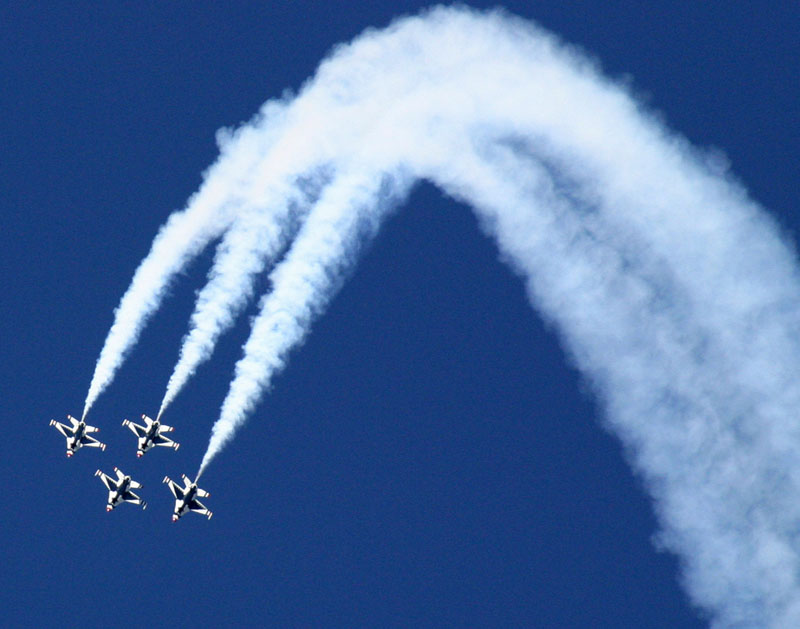Fighter Jet News
F-16 Fighting Falcon News
Thunderbirds need enlisted volunteers
December 15, 2005 (by
Staff Sgt. Josh Clendenen) -
The U. S. Air Force Air Demonstration Squadron is looking for professionals to join an elite team known world-wide for precision flying and community involvement.
Volunteers are needed in eight career fields.
"The Thunderbirds have more than 34 career fields represented in the squadron," said Chief Master Sgt. Ted Field, chief enlisted manager of the Thunderbirds. "We have a job for just about everyone out there."
The Air Force Specialty Codes needed are 2A3X2 Avionics, 2A3X3B Crew Chief, 2A6X3 Egress, 2A6X4 Fuels, 2A6X6 Electro/Environmental, 2A7X3 Structures, 3N0X1 Public Affairs, 3V0X1 Graphic Artist and 8F000 First Sergeant. For information on the application process, visit www.airforce.com/thunderbirds.
"Even if (a) career field is not listed, we are accepting applications," Chief Field said. "Anyone can submit an application for a job in one of the (34) career fields we have. We?ll keep the application on file for six months, and if a job comes open we will look at the applications we have and we?ll try to fill them with those."
One of the common misconceptions about the Thunderbirds is the team is gone all the time.
"We do travel across the United States and in some cases across the world," Chief Field said. "But we?re not gone all the time. We have a good amount of time at home, but we do travel."
During the season, a typical week begins on Thursday when the team travels to its show site. Pilots fly their aircraft and support personnel typically travel in a C-17. As soon as the jets touch down, technicians recover their aircraft and perform post-flight tasks. Meanwhile, public affairs prepares for enlistment and re-enlistment ceremonies, media interviews and orientation flights.
Communications specialists videotape the arrival and landing. The advance pilot, having arrived the day before, briefs the team on subjects including transportation and the weather.
Friday is usually a practice day, giving the Thunderbird pilots an opportunity to become familiar with the terrain and local landmarks. Crew chiefs and their assistants attend to pre-flight tasks.
After the practice flight, the team meets with members of the community whose special needs might prevent them from attending a crowded show. On Saturday and Sunday, the team flies its full show and meets with the crowd to sign autographs for 20 minutes. On Monday, the team heads back to Nellis AFB, Nev., then goes back to work Tuesday.
"It seems really busy, and to some extent it is, but the people you get to meet with on the road make it all worthwhile," Chief Field said. "The bottom line is ? an assignment to the Thunderbirds is the chance of a lifetime."
"The Thunderbirds have more than 34 career fields represented in the squadron," said Chief Master Sgt. Ted Field, chief enlisted manager of the Thunderbirds. "We have a job for just about everyone out there."
The Air Force Specialty Codes needed are 2A3X2 Avionics, 2A3X3B Crew Chief, 2A6X3 Egress, 2A6X4 Fuels, 2A6X6 Electro/Environmental, 2A7X3 Structures, 3N0X1 Public Affairs, 3V0X1 Graphic Artist and 8F000 First Sergeant. For information on the application process, visit www.airforce.com/thunderbirds.
"Even if (a) career field is not listed, we are accepting applications," Chief Field said. "Anyone can submit an application for a job in one of the (34) career fields we have. We?ll keep the application on file for six months, and if a job comes open we will look at the applications we have and we?ll try to fill them with those."
One of the common misconceptions about the Thunderbirds is the team is gone all the time.
"We do travel across the United States and in some cases across the world," Chief Field said. "But we?re not gone all the time. We have a good amount of time at home, but we do travel."
During the season, a typical week begins on Thursday when the team travels to its show site. Pilots fly their aircraft and support personnel typically travel in a C-17. As soon as the jets touch down, technicians recover their aircraft and perform post-flight tasks. Meanwhile, public affairs prepares for enlistment and re-enlistment ceremonies, media interviews and orientation flights.
Communications specialists videotape the arrival and landing. The advance pilot, having arrived the day before, briefs the team on subjects including transportation and the weather.
Friday is usually a practice day, giving the Thunderbird pilots an opportunity to become familiar with the terrain and local landmarks. Crew chiefs and their assistants attend to pre-flight tasks.
After the practice flight, the team meets with members of the community whose special needs might prevent them from attending a crowded show. On Saturday and Sunday, the team flies its full show and meets with the crowd to sign autographs for 20 minutes. On Monday, the team heads back to Nellis AFB, Nev., then goes back to work Tuesday.
"It seems really busy, and to some extent it is, but the people you get to meet with on the road make it all worthwhile," Chief Field said. "The bottom line is ? an assignment to the Thunderbirds is the chance of a lifetime."
Republished with kind permission of Hilltop Times.
Related articles:
Forum discussion:
Tags
Forum discussion:
- Start a discussion about this article in the F-16.net forum.
Tags

